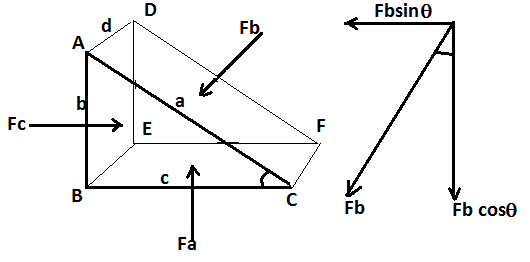
Proof the pascal’s law.


Answer
437.2k+ views
5 likes
- Hint: Pascal’s law states that in a closed container if the fluid is in a rest condition (not moving) then a pressure change in one part of the container is transmitted to every part of the fluid and to the wall. In this phenomenon there is no loss of the fluid. In this principle the condition is that the gravity is neglected.
Complete step-by-step answer:
Statement- The intensity of pressure at a point in a fluid at rest is the same in all directions. (neglecting the effect of gravity)
Proof:
Here from the above diagram let us assume that the
And the forces acting on the faces of the triangular block are
We know that pressure is equal to the force divided by the area.
Mathematically,
So, from the above equation we can write the formula for the pressure force, that is,
All the three pressures will exert a force on their respective faces normal to the surface.
Therefore, force
In the above diagram let angle BAC=
So now in the
Since the above triangular block is in equilibrium then the net force on it will be zero.
So, balancing the forces for the triangular block to be in equilibrium,
and
On putting the values of
For equation (1),
Similarly, for equation (2)
Now from equation (3) and equation (4), we see that
So,
Hence proved.
Note: Applications of the pascal’s law are very useful in our day to day life and in some other industrial applications. Pascal’s law is used in:
Force amplification in braking systems of many vehicles
Hydraulic press.
Automatic lift (hydraulic jack) at many service stations.
Artesian wells
Water towers and
Dams, etc.
Complete step-by-step answer:
Statement- The intensity of pressure at a point in a fluid at rest is the same in all directions. (neglecting the effect of gravity)
Proof:
Here from the above diagram let us assume that the
And the forces acting on the faces of the triangular block are
We know that pressure is equal to the force divided by the area.
Mathematically,
So, from the above equation we can write the formula for the pressure force, that is,
All the three pressures will exert a force on their respective faces normal to the surface.
Therefore, force
In the above diagram let angle BAC=
So now in the
Since the above triangular block is in equilibrium then the net force on it will be zero.
So, balancing the forces for the triangular block to be in equilibrium,
and
On putting the values of
For equation (1),
Similarly, for equation (2)
Now from equation (3) and equation (4), we see that
So,
Hence proved.
Note: Applications of the pascal’s law are very useful in our day to day life and in some other industrial applications. Pascal’s law is used in:
Force amplification in braking systems of many vehicles
Hydraulic press.
Automatic lift (hydraulic jack) at many service stations.
Artesian wells
Water towers and
Dams, etc.
Recently Updated Pages
Master Class 11 Economics: Engaging Questions & Answers for Success

Master Class 11 Business Studies: Engaging Questions & Answers for Success

Master Class 11 Accountancy: Engaging Questions & Answers for Success

Master Class 11 English: Engaging Questions & Answers for Success

Master Class 11 Computer Science: Engaging Questions & Answers for Success

Master Class 11 Maths: Engaging Questions & Answers for Success

Trending doubts
In which part of the body the blood is purified oxygenation class 11 biology CBSE

1 Quintal is equal to a 110 kg b 10 kg c 100kg d 1000 class 11 physics CBSE

Find the value of the expression given below sin 30circ class 11 maths CBSE

If the HCF of 657 and 963 is expressible in the fo-class-11-maths-CBSE

How do I convert ms to kmh Give an example class 11 physics CBSE

How many ATP molecules are produced from the complete class 11 biology CBSE




